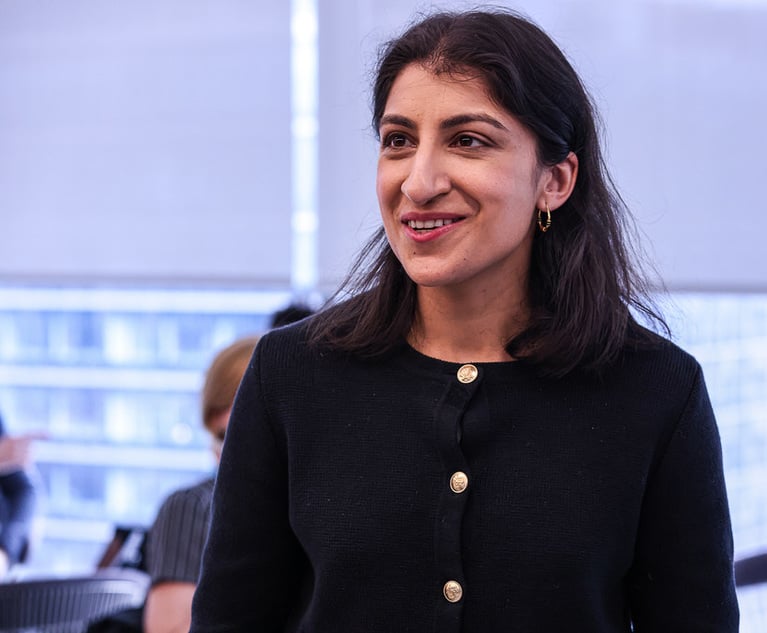 AARP headquarters in Washington, D.C. Credit: Diego M. Radzinschi / NLJ
AARP headquarters in Washington, D.C. Credit: Diego M. Radzinschi / NLJAge Discrimination Case Moves Forward Against Ohio State University
An Equal Employment Opportunity Commission investigation that found a class of older employees at Ohio State University faced age discrimination came as a suit targeting the university for certain practices is moving forward.
December 11, 2017 at 05:54 PM
4 minute read
Updated Dec. 12
An Equal Employment Opportunity Commission investigation that found a class of older employees at Ohio State University faced age discrimination came as a suit targeting the university for certain practices is moving forward.
The plaintiffs, Julianne Taaffe and Kathryn Moon—administrative and professional staff members at Ohio State's English as a Second Language Program—filed charges with the EEOC and brought a lawsuit in the U.S. District Court for the Southern District of Ohio in 2014. They claimed the university engaged in a pattern of age discrimination and retaliation.
The parallel proceedings are moving forward, but age discrimination claims can face challenges. The Age Discrimination in Employment Act is celebrating its 50th anniversary this week and the Ohio case and other recent disputes, often taken on by the AARP Legal Foundation, highlight the difficulty of tackling discrimination against older workers.
A 2009 U.S. Supreme Court decision created exceptions that required age lawsuits to prove that age was the motivating factor for discrimination, a higher bar than other civil rights protections under Title VII of the Civil Rights Act of 1964.
In the Ohio State case, the EEOC sent letters to the plaintiffs that said an investigation found that throughout 2013 and 2014 affected employees at the university were “ultimately forced to choose between resignation/retirement or being reclassified into less desirable positions.” The evidence suggests that university officials were aware and support the intent to discriminate, according to the letter. The letter notes the commission is engaged in a conciliation agreement with the parties.
In the federal civil case, U.S. District Judge Chelsey Vascura this month ruled the plaintiffs' attorneys—Ohio-based attorney Fred Gittes and a team from the AARP Foundation Litigation—will be allowed to question university officials who tried to block the continued search for evidence of ongoing discrimination policies and practices.
The lawsuit alleged the employment-hiring pattern stems back to 2010, where the executive director of the ESL program referred to the staff as “an extraordinarily change-average population of people almost all of whom are over 50, contemplating retirement (or not) and it's like herding hippos.” The email, which praised a “dynamic 30-something” employee, was forwarded to university officials who did not take action and agreed with the assessment, the lawsuit claimed.
In court documents, the university has denied the allegations, claiming school officials corrected any unlawful or discriminatory behavior. The university, represented by a team from Ice Miller LLP, also has argued that its employees are not covered by federal discrimination law.
Ohio State University said in a statement: “The Ohio State University is committed to hiring a diverse and inclusive work force and providing equal opportunities for all. The university does not tolerate or engage in discrimination in any form. We are studying the EEOC finding and considering all of our options.”
Taaffe and Moon have since been reinstated in their positions but their attorneys claim they lost their position and back wages during the time they were out of work.
There's no certainty the EEOC will sue Ohio State University. However the pending federal civil case is resolved, it will not yield any monetary damages. Any complaint brought by the EEOC or settlement could lead to a monetary reward, as well as requiring measures to prevent future discrimination against older workers, AARP attorney Dara Smith said.
“It's an ongoing pattern and really no indication that it won't happen again in the future,” Smith said about the claims against the university.
The EEOC's letter about Ohio State University age-discrimination claims is posted below:
Read more:
This content has been archived. It is available through our partners, LexisNexis® and Bloomberg Law.
To view this content, please continue to their sites.
Not a Lexis Subscriber?
Subscribe Now
Not a Bloomberg Law Subscriber?
Subscribe Now
NOT FOR REPRINT
© 2025 ALM Global, LLC, All Rights Reserved. Request academic re-use from www.copyright.com. All other uses, submit a request to [email protected]. For more information visit Asset & Logo Licensing.
You Might Like
View All
'The Tobacco Industry of This Decade': Slew of Class Actions Accuse DraftKings of Creating Addicts
5 minute read
4th Circuit Revives Racial Harassment Lawsuit Against North Carolina School District
3 minute read
Khan Defends FTC Tenure, Does Not Address Post-Inauguration Plans

‘Old Home Week’: Justice Breyer Hears Challenge to Cruise Ship Ordinance in 1st Circuit
Trending Stories
- 1What to Know About the New 'Overlapping Directorship' Antitrust Development
- 2'Quiet, Appropriate End:' NY Court of Appeals Formally Removes Erin Gall From Bench
- 3Just One Cookie? Justices to Decide Liability for Half-Truths
- 440% Contingency: A New Ruling Just Cost This Plaintiff Team $827K in Legal Fees
- 5Runners-Up and Shout-Outs for Litigator of the Week
Who Got The Work
Michael G. Bongiorno, Andrew Scott Dulberg and Elizabeth E. Driscoll from Wilmer Cutler Pickering Hale and Dorr have stepped in to represent Symbotic Inc., an A.I.-enabled technology platform that focuses on increasing supply chain efficiency, and other defendants in a pending shareholder derivative lawsuit. The case, filed Oct. 2 in Massachusetts District Court by the Brown Law Firm on behalf of Stephen Austen, accuses certain officers and directors of misleading investors in regard to Symbotic's potential for margin growth by failing to disclose that the company was not equipped to timely deploy its systems or manage expenses through project delays. The case, assigned to U.S. District Judge Nathaniel M. Gorton, is 1:24-cv-12522, Austen v. Cohen et al.
Who Got The Work
Edmund Polubinski and Marie Killmond of Davis Polk & Wardwell have entered appearances for data platform software development company MongoDB and other defendants in a pending shareholder derivative lawsuit. The action, filed Oct. 7 in New York Southern District Court by the Brown Law Firm, accuses the company's directors and/or officers of falsely expressing confidence in the company’s restructuring of its sales incentive plan and downplaying the severity of decreases in its upfront commitments. The case is 1:24-cv-07594, Roy v. Ittycheria et al.
Who Got The Work
Amy O. Bruchs and Kurt F. Ellison of Michael Best & Friedrich have entered appearances for Epic Systems Corp. in a pending employment discrimination lawsuit. The suit was filed Sept. 7 in Wisconsin Western District Court by Levine Eisberner LLC and Siri & Glimstad on behalf of a project manager who claims that he was wrongfully terminated after applying for a religious exemption to the defendant's COVID-19 vaccine mandate. The case, assigned to U.S. Magistrate Judge Anita Marie Boor, is 3:24-cv-00630, Secker, Nathan v. Epic Systems Corporation.
Who Got The Work
David X. Sullivan, Thomas J. Finn and Gregory A. Hall from McCarter & English have entered appearances for Sunrun Installation Services in a pending civil rights lawsuit. The complaint was filed Sept. 4 in Connecticut District Court by attorney Robert M. Berke on behalf of former employee George Edward Steins, who was arrested and charged with employing an unregistered home improvement salesperson. The complaint alleges that had Sunrun informed the Connecticut Department of Consumer Protection that the plaintiff's employment had ended in 2017 and that he no longer held Sunrun's home improvement contractor license, he would not have been hit with charges, which were dismissed in May 2024. The case, assigned to U.S. District Judge Jeffrey A. Meyer, is 3:24-cv-01423, Steins v. Sunrun, Inc. et al.
Who Got The Work
Greenberg Traurig shareholder Joshua L. Raskin has entered an appearance for boohoo.com UK Ltd. in a pending patent infringement lawsuit. The suit, filed Sept. 3 in Texas Eastern District Court by Rozier Hardt McDonough on behalf of Alto Dynamics, asserts five patents related to an online shopping platform. The case, assigned to U.S. District Judge Rodney Gilstrap, is 2:24-cv-00719, Alto Dynamics, LLC v. boohoo.com UK Limited.
Featured Firms
Law Offices of Gary Martin Hays & Associates, P.C.
(470) 294-1674
Law Offices of Mark E. Salomone
(857) 444-6468
Smith & Hassler
(713) 739-1250










